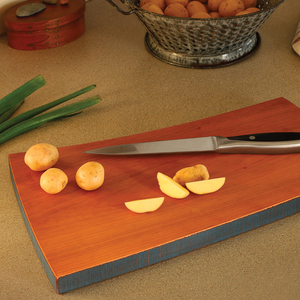Cutting boards: What cooks want you to know
End grain or no end grain? Woodworkers may have to confer with the chefs on this one.I was talking with prospective client about a making him a cutting board. I confidently recommend end grain when people ask about cutting boards. But he did some research and showed me this video that debunks the idea that end grain is the superior choice. See link below. The video is 3 years old, so maybe you’ve come across it already. If you haven’t, I would love to hear your take on it. Also, there are other very interesting points these kitchen professionals make about cutting boards that I think woodworkers would like to know.
-Michael Olin
Michael sent this into the podcast mailbox—and we’ll certainly discuss it on the show—but I thought it would be worth sharing it here. I consider America’s Test Kitchen’s reviews to be a gold standard and have bought more than a few cooking items because they declared them to be worth the money. I would have a hard time arguing that many woodworkers know more about using cutting boards than they do, so I’m going to listen to their advice.
But you never know, maybe we have a chef or two out there slinging sawdust on the weekends. What say you?
-Made You Look are videos that we’ve found on the web that we thought were worth sharing with our audience. Let us know if you find anything you think is worth a look in the comments below!























Comments
That was very useful, thanks Ben and Michael. So long grain teak is best.
I've always wondered if it was safe to cut meat on a wood cutting board. or is it just for veggies and such?
Wood is naturally anti-bacterial so is fine for meat. It is however not a good idea to use the same board for raw and cooked meats.
https://www.fsis.usda.gov/food-safety/safe-food-handling-and-preparation/food-safety-basics/cutting-boards
The statement "we saw no difference in our robotic arm testing" in reference to end grain versus others was eye opening. I generally try to avoid truisms and back my opinions up with a little research.
I must admit I have never seen laboratory level testing of end grain versus edge grain boards yet I have felt that end grain is superior . . . victim of media exposure???
I will chime in that bamboo is second only to glass in my "don't even go there" arena of knife destroyers. Edge grain or end grain will remain my go-to's for cutting boards that will get commercial level use. Thanks for the insightful video on the test results. Good info in this area can be hard to find ;-)
First attached pic is a board inspired by FWW article on Scott Lewis. Other board is one I built for a friend who likes optical illusions.
Interesting video. I too was surprised by the final recommendation. Although I have never used teak in my woodworking I've always heard that it was especially hard on blades thus requiring frequent Sharpening. As an aspiring home chef I will agree that there is definitely a feel factor involved; The feel of the knife against the cutting surface is a big thing for me. Cutting on a glass surface is terrible followed next by plastic and then bamboo. The bamboo surface feels too hard and slippery. I'm an owner of one of the brands in their testing: BooS Block. Except my variation is a floor standing 24-inch square, 10-inch thick maple end-grain butcher block. As a woodworker, who doesn't love seeing a 10 inch thick slab of any kind of wood? So that makes my situation somewhat unique in that there is no submersing that block in water for cleaning. Second, since I don't eat any kind of meat that also cuts down on the need for the type of deep cleaning shown in their video and the heavy abuse afforded by a cleaver. And lastly since I don't eat meat I probably chop and eat more vegetables in a month than many people in an entire year. The block in the picture is at least 20 years old, every glue seam in the top end grain is still tight and completely intact. I wipe it down daily with a damp cloth, oil it a few times per year. No complaints and I would still recommend it to anyone.
Thank you. This was very informative. It's great to hear from professionals in the field who use cutting boards daily to dispel erroneous assumptions and myths.
TRUE!
ALWAYS ASK THE CUSTOMER/USER WHA THEY WANT!!!!
What does Bob Van Dyke think about this?
I'm sure he has opinions!
Thanks for posting this. Especially liked the robotic knife testing. I have preferred the look of edge grain boards vs end grain and now have a reason to focus on those.
I've made several edge grain walnut cutting boards. I agree with the tester that mass production will more likely have inherent flaws in the construction of the block that can cause failures. However, as woodworkers, following the techniques in articles I've used from FWW, we can build better than a factory and have it hold up beautifully. Also, I would venture to guess that the end-grain boards were not oiled up front to be completely saturated. I agree end-grain takes more oil, but it definitely shows much less damage from the knives than anything else.
Thanks for posting this, Ben. I wonder which glue would be best for making an edge-grain teak cutting board. I was thinking maybe Titebond III with a thorough wipe down with acetone prior to the glue up. Thoughts?
As a home cook and amateur woodworker, I loved this informative video. But the video did raise a question for me that I've always wanted to ask - the video recommends mineral oil for maintenance. However, I've always find using it annoying because it never dries. I use walnut oil instead. I'm aware of the allergy concern, but since the only people I cook for are family and friends, I don't see a reason not to use walnut. Am I missing something?
Nice article. What a good way to combine woodworking with outside testing. I always thought that end grain boards were preferable since long grain might have a tendency to splinter. End grain won't do that. I don't have any teak but I do have Iroko (AKA Africa Teak) It's not teak but it does have the some similar properties, I've been told. Higher oil content, etc. I was inspired to make a board out of scraps. I'll see how it hold up to regular use.
The 8/4 teak is $49.99 BF on my preferred online store. And they are selling the 18x24x1.5 cutting board for $119. How in the world???
I was wondering that too. It certainly wouldn't make financial sense to make my own...
Looks like Proteak, the manufacturer, owns the teak farms. So, they likely make these out of pieces that would normally be too small to sell as anything else. Kind of brilliant.
Log in or create an account to post a comment.
Sign up Log in